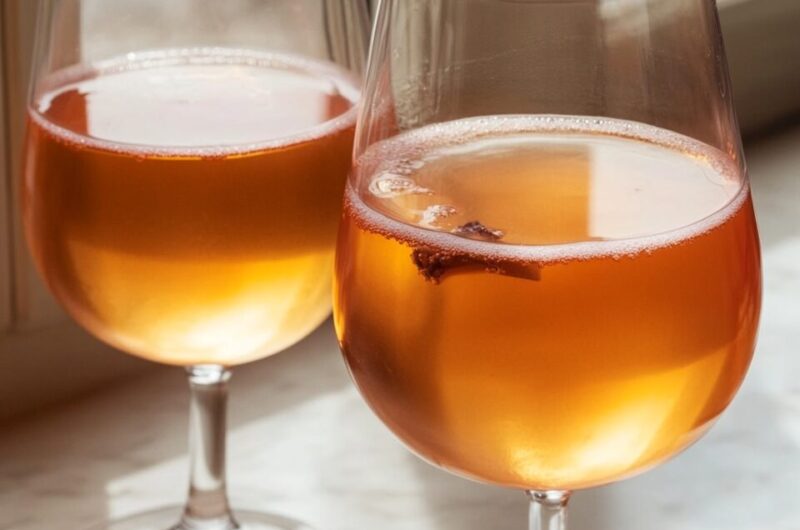Rhubarb wine is one of those charming, old-world drinks that brings the essence of a spring or early summer garden right to your glass. Though rhubarb is technically a vegetable, it behaves much like a fruit in culinary use and its naturally tangy, bright flavor makes it an excellent candidate for fermentation. Unlike grapes, which come pre-packed with sugar and yeast-friendly skins, rhubarb requires a little extra help to become wine but the result is more than worth it. The transformation of these tart, fibrous stalks into a delicate, lightly sweetened, and subtly floral beverage is nothing short of magical. For home brewers and culinary adventurers, rhubarb wine offers a unique project that requires very little equipment and delivers high rewards: a blushing pink wine with a refreshing, crisp profile that matures beautifully over time.
Full Recipe:
Ingredients:
-
3.5 lbs fresh rhubarb stalks, chopped
-
3 lbs granulated sugar
-
1 gallon filtered water
-
1/2 tsp wine yeast
-
1 tsp yeast nutrient (optional but recommended)
-
1 Campden tablet (optional, to kill wild yeasts)
-
Juice of 1 lemon
-
1 sterilized glass fermenting jar (1-gallon)
-
Airlock and bung
Directions:
-
Place the chopped rhubarb into a large, clean container and cover it with the sugar. Stir well to coat evenly.
-
Cover the container with a cloth and let it sit at room temperature for 2-3 days. Stir once daily until the sugar has mostly dissolved and the rhubarb releases its juice.
-
Pour the rhubarb and its syrup into a sterilized fermenting jar. Add the lemon juice and fill with water to the 1-gallon mark.
-
If using, crush and add the Campden tablet. Let sit for 24 hours, covered with a cloth.
-
After 24 hours, add the wine yeast and yeast nutrient. Stir gently.
-
Fit the airlock and place the jar in a dark, cool spot for primary fermentation (about 3-4 weeks). Bubbles should be visible in the airlock.
-
After primary fermentation slows, siphon the wine into another sterilized container to leave the sediment behind.
-
Continue to ferment for another 4-6 weeks, or until bubbling stops.
-
Once fermentation is complete, siphon into sterilized bottles, seal, and age for at least 3 months (6–12 months for optimal flavor).
Prep Time: 30 minutes | Fermentation Time: 2–3 months | Total Time: ~3 months
Kcal: 110 kcal per 5 oz serving | Servings: ~20 servings per gallon
A Brief History of Rhubarb in Winemaking
Rhubarb has a curious origin. Originally cultivated in Asia for medicinal purposes, it made its way into European gardens in the 17th and 18th centuries. With the advent of affordable sugar in the 19th century, rhubarb became a beloved ingredient for pies, compotes, and yes wine.
Traditional English and Scandinavian households in particular embraced rhubarb wine, especially in rural communities where grapes were not available or practical to grow. Country wines (or “hedgerow wines”) made from seasonal, foraged, or garden-grown produce were economical and celebrated seasonal bounty.
Rhubarb wine became popular not only for its taste but also for its symbolic link to spring renewal, preservation, and home craft. In recent years, as interest in sustainable living and fermentation has resurged, rhubarb wine has found new life among homesteaders, urban gardeners, and curious foodies alike.
Why Rhubarb Makes Great Wine
Rhubarb’s signature tartness might not suggest “wine” at first thought but this quality is what makes it shine. When balanced with sugar and allowed to ferment slowly, rhubarb’s astringency mellows into a complex flavor that dances between citrusy brightness and apple-like crispness.
Here are a few reasons rhubarb excels in home winemaking:
-
High Acidity: Rhubarb naturally contains oxalic acid, giving it a tangy base perfect for a wine with refreshing backbone.
-
Aromatic Complexity: Though subtle, rhubarb’s aroma carries herbaceous, green, and even slightly floral undertones that deepen during fermentation.
-
Adaptability: Rhubarb blends well with other fruits or herbs, allowing for creative flavor layering.
-
Color & Clarity: Depending on the variety, rhubarb wine can range from blush pink to a pale rose, with beautiful clarity when properly racked.
While rhubarb lacks the natural sugars and tannins of grapes, this is easily remedied by adding sugar, lemon juice for brightness, and optional yeast nutrients to help fermentation along.
Equipment and Fermentation Basics
One of the appeals of homemade rhubarb wine is that you don’t need a full winery setup. With a few fermentation essentials, you’re well on your way:
-
A clean glass fermentation vessel (1-gallon jug is typical for beginners)
-
An airlock and rubber bung
-
A food-safe siphon
-
Bottles with corks or screw tops
-
Optional: a hydrometer to track sugar levels, a Campden tablet to neutralize wild yeasts
Fermentation typically happens in two stages: the first (primary fermentation) where the yeast is most active and converts sugars to alcohol, and the second (secondary fermentation or aging), where flavors mellow and the wine clarifies.
This process takes anywhere from two to six months, though many enthusiasts recommend aging for at least six months to a year to achieve optimal smoothness and depth.
Flavor Profile and Pairing Ideas
Rhubarb wine is light-bodied, clean, and delicately floral with a balance of tart and sweet. Think of it as a cousin to dry rosé or fruit-forward white wines like Riesling or Pinot Grigio.
Depending on the sugar ratio and fermentation time, you can produce:
-
Dry rhubarb wine – crisp and sharp, excellent with seafood or herby dishes
-
Semi-sweet rhubarb wine – more fruit-forward, ideal for sipping or pairing with soft cheeses
-
Sweet dessert-style rhubarb wine – great for after-dinner enjoyment or with fruit tarts and sorbet
For an enhanced experience, rhubarb wine can be gently carbonated or infused with herbs such as mint, lemon verbena, or basil.
Storage and Aging Tips
After fermentation, rhubarb wine should be carefully racked (transferred to a clean container) at least once to remove sediment, also called “lees.” This prevents unwanted flavors from developing and ensures a clear, bright wine.
Once bottled, store the wine in a cool, dark place. The longer it ages, the more balanced and nuanced it becomes. Most rhubarb wines are drinkable after three months, but peak at 6–12 months. Some even hold their flavor for years if well-sealed.
Check your bottles periodically for cloudiness, off-smells, or pressure build-up. Proper sanitation at each stage of the process is key to a successful batch.
Sustainability and Seasonal Joy
One of the biggest joys of making rhubarb wine is the connection it fosters with the seasons. Rhubarb’s early-spring appearance makes it one of the first harvestable “fruits” of the gardening year, symbolizing renewal and abundance.
Because rhubarb grows prolifically (and often more than we can use in pies), wine is a practical and rewarding way to preserve its flavor. This also reduces food waste and supports the idea of garden-to-glass sustainability.
By making your own wine from a simple garden crop, you engage in a rich tradition of self-sufficiency, creativity, and celebration of natural ingredients.
Health Considerations
In moderation, homemade wines like rhubarb wine can be a delightful and relatively natural beverage choice. However, it’s important to note:
-
Oxalic Acid Caution: Rhubarb leaves contain toxic levels of oxalic acid and should never be used in winemaking only stalks are safe.
-
Alcohol Content: Depending on sugar content and fermentation time, rhubarb wine typically lands around 10–12% ABV.
-
Sugar Monitoring: Because sugar is added, it’s best enjoyed in moderation if you’re watching your sugar intake.
Always label your batches clearly with dates and alcohol estimates, and keep them out of reach of children or pets.
Conclusion:
Rhubarb wine is a beautiful blend of tradition, flavor, and homegrown resourcefulness. It embodies the slow food movement where patience and care are rewarded with something uniquely personal and delicious.
With just a few simple tools and ingredients, you can create a wine that feels like spring in a bottle. Whether you enjoy it chilled on a warm evening or save it to mark a special occasion, rhubarb wine is a delightful nod to nature, craft, and culinary creativity.








